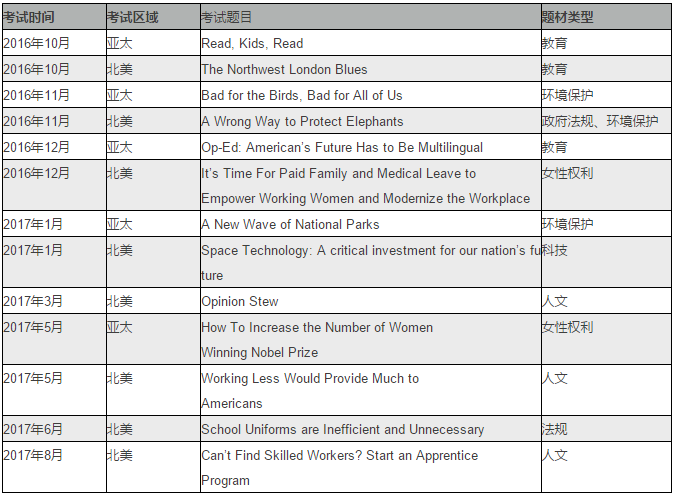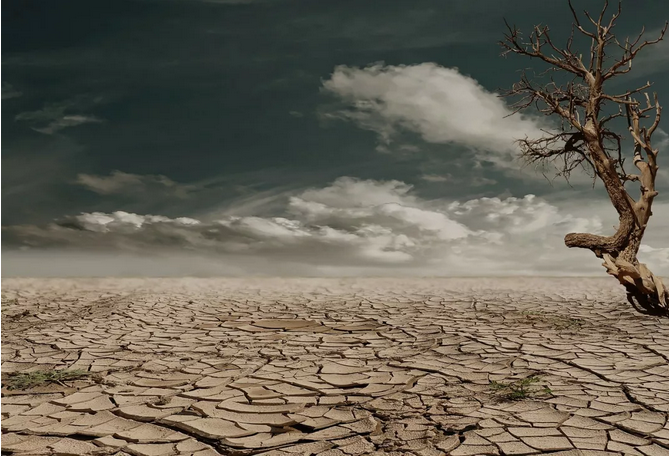新SAT写作文章类型及考试趋势汇总
我们从过去23场新SAT考试中截取13篇题目按题材整理如下表所示:

从上表可以发现在SAT写作的阅读材料中,教育、环保、人文类文章仍是重点,在备考写作的过程中,重要的不是如何生成观点,而是面对各色各样的态度和言论,公众究竟会有怎样的反应和理性、感性上的认知和回馈。只有将这一方面的敏感度培养起来,才能对考试中的文章和整齐划一的文字转化成有血有肉的评论式作文。
在实际写作的教学实践中,很多考生都是执意的背下所谓的总分总模板,现在SAT写作在评分标准上也是力图于去模板化,所以固执的背下所谓的模板并不会高分。有时候在基础阶段甚至连文章的意思都没有弄懂,
举个例子:
下面是2017年12月北美写作原文和文章翻译,看看是否可以像给出的翻译来理解原文呢?
Why Sand is Disappearing?
BERKELEY, Calif. — TO those of us who visit beaches only in summer, they seem as permanent a part of our natural heritage as the Rocky Mountains and the Great Lakes. But shore dwellers know differently. Beaches are the most transitory of landscapes, and sand beaches the most vulnerable of all. During big storms, especially in winter, they can simply vanish, only to magically reappear in time for the summer season.
加利福尼亚伯克利——对于只在夏天去海边游玩的人来说,海滩仿佛是一种的自然遗产,就像落基山脉和五大湖一样。然而,住在海边的人知道,事实并非如此。海滩是最容易转瞬即逝的地貌,而沙滩又是其中最为脆弱的一种。遇到大风暴,尤其是在冬天,它们会消失,待到来年夏季将至的时候又会神奇地及时重现。
It could once be said that “a beach is a place where sand stops to rest for a moment before resuming its journey to somewhere else,” as the naturalist D. W. Bennett wrote in the book “Living With the New Jersey Shore.” Sand moved along the shore and from beach to sea bottom and back again, forming shorelines and barrier islands that until recently were able to repair themselves on a regular basis, producing the illusion of permanence.
自然科学家D·W·本内特(D. W. Bennett)在《与新泽西海滩共度时光》(Living With the New Jersey Shore)一书中写道,“海滩是沙子在继续前往别处之前停留片刻的地方。”曾几何时,的确可以这么说。沙子沿着水岸运动,从滩涂到海底再到滩涂,塑造了海岸线和堰洲岛。直到不久前,这些地貌还能经常自我修复,制造出一种永恒的假象。
Today, however, 75 to 90 percent of the world’s natural sand beaches are disappearing, due partly to rising sea levels and increased storm action, but also to massive erosion caused by the human development of shores. Many low-lying barrier islands are already submerged.
然而今天,世界上75%到90%的自然沙滩正在消失。部分原因在于海平面上升和风暴活动增加,但更重要的是,人类对海滩的开发造成了大规模的侵蚀。许多地势较低的堰洲岛已经被海水淹没。

Yet the extent of this global crisis is obscured because so-called beach nourishment projects attempt to hold sand in place and repair the damage by the time summer people return, creating the illusion of an eternal shore.
可是,由于所谓的“人工育滩”计划,这一全球性危机的严重程度遭到了忽视。这些工程努力在夏季游客到来之前将沙子留在原处并修复损失,制造出一种海滩永在的幻象。
Before next summer, endless lines of dump trucks will have filled in bare spots and restored dunes. Virginia Beach alone has been restored more than 50 times. In recent decades, East Coast barrier islands have used 23 million loads of sand, much of it mined inland and the rest dredged from coastal waters — a practice that disturbs the sea bottom, creating turbidity that kills coral beds and damages spawning grounds, which hurts inshore fisheries.
下个夏天到来之前,看不到尽头的自卸车队会运来材料填补裸露的地表并修复沙丘。光是弗吉尼亚海滩,就被恢复了逾50次。近几十年里,美国东海岸的堰洲岛用掉了2300万车的沙子,其中许多采自陆地,其余则从沿海水域挖掘。挖沙的做法会干扰海床,产生不利于珊瑚礁生存并会破坏生物繁殖地的浑浊海水,从而损害近海渔业。
The sand and gravel business is now growing faster than the economy as a whole. In the United States, the market for mined sand has become a billion-dollar annual business, growing at 10 percent a year since 2008. Interior mining operations use huge machines working in open pits to dig down under the earth’s surface to get sand left behind by ancient glaciers. But as demand has risen — and the damming of rivers has held back the flow of sand from mountainous interiors — natural sources of sand have been shrinking.
砂石行业的增长如今比整体经济更为迅猛。在美国,开采出来的沙子已形成了每年上十亿美元的市场规模,2008年以来的年增长率为10%。内陆采砂采用大型机械露天作业,挖开地表,以便开采出古老冰川留下的砂石。不过,随着需求的增加,以及在水上修建大坝的行为阻止了泥沙从多山的内陆地区向外的迁移,砂石自然资源一直在缩减。
One might think that desert sand would be a ready substitute, but its grains are finer and smoother; they don’t adhere to rougher sand grains, and tend to blow away. As a result, the desert state of Dubai brings sand for its beaches all the way from Australia.
人们或许会认为,来自沙漠的沙子应当是现成的替代品。但实际上,这种沙粒更细、更光滑,不能与较为粗糙的沙粒黏合,而且容易被吹走。因此,沙漠之国迪拜需要为了本地的海滩万里迢迢从澳大利亚进口沙子。
And now there is a global beach-quality sand shortage, caused by the industries that have come to rely on it. Sand is vital to the manufacturing of abrasives, glass, plastics, microchips and even toothpaste, and, most recently, to the process of hydraulic fracturing. The quality of silicate sand found in the northern Midwest has produced what is being called a “sand rush” there, more than doubling regional sand pit mining since 2009.
现在出现了海滩用沙的全球性短缺,而导致这种短缺的是越来越依赖砂石的各大行业。沙子是生产磨料、玻璃、塑料、微芯片乃至牙膏的关键用料,最近还成为水力压裂工艺中不可或缺的一环。美国中西部北面发现的硅砂在当地掀起了一股“淘沙热”,使得该地区的沙坑开采活动自2009年以来翻番有余。
But the greatest industrial consumer of all is the concrete industry. Sand from Port Washington on Long Island — 140 million cubic yards of it — built the tunnels and sidewalks of Manhattan from the 1880s onward. Concrete still takes 80 percent of all that mining can deliver. Apart from water and air, sand is the natural element most in demand around the world, a situation that puts the preservation of beaches and their flora and fauna in great danger. Today, a branch of Cemex, one of the world’s largest cement suppliers, is still busy on the shores of Monterey Bay in California, where its operations endanger several protected species.
不过,所有工业生产中耗沙量的是混凝土行业。自19世纪80年代以来,来自长岛华盛顿港的砂石——1.1亿立方米——一直在为曼哈顿的通道和路面建设贡献力量。采砂业的80%产量目前依然流向了混凝土行业。除了水和空气,沙子是全球范围内需求量的自然产物。这一现状威胁到了对海滩和生长在其中的动植物进行保护的工作。就在当下,世界的水泥供应商之一西麦斯集团(Cemex)旗下的一家分公司,仍然在加州蒙特雷湾的海滩积极采砂,危及到了数种保护物种。

The huge sand mining operations emerging worldwide, many of them illegal, are happening out of sight and out of mind, as far as the developed world is concerned. But in India, where the government has stepped in to limit sand mining along its shores, illegal mining operations by what is now referred to as the “sand mafia” defy these regulations. In Sierra Leone, poor villagers are encouraged to sell off their sand to illegal operations, ruining their own shores for fishing. Some Indonesian sand islands have been devastated by sand mining.
全球范围内兴起的大型采砂活动中,许多都属非法行为,但它们并未进入发达国家的视野,也未被放在心上。不过在印度,政府已出手限制在海岸附近采砂,但那些已被人称为“采砂黑手党”的非法开采集团对这些监管规定视而不见。在塞拉利昂,贫困村民受到鼓励,要将沙子卖给非法企业,从而彻底破坏了当地的近海捕鱼环境。一些印度尼西亚的沙岛因采砂而遭遇重创。
It is time for us to understand where sand comes from and where it is going. Sand was once locked up in mountains and it took eons of erosion before it was released into rivers and made its way to the sea. As Rachel Carson wrote in 1958, “in every curving beach, in every grain of sand, there is a story of the earth.” Now those grains are sequestered yet again — often in the very concrete sea walls that contribute to beach erosion.
是时候让我们了解沙子的来源和去向了。它曾被困在山上的岩石里,经过亿万年的侵蚀才得以进入山川河流,然后来到海里。正如蕾切尔·卡森(Rachel Carson)1958年写下的那样,“在每个蜿蜒的海滩,在每颗沙粒之中,都藏有大地的故事。”现在,这些沙砾却再次受困——往往就在那些助推海滩侵蚀的混凝土防波堤里。
We need to stop taking sand for granted and think of it as an endangered natural resource. Glass and concrete can be recycled back into sand, but there will never be enough to meet the demand of every resort. So we need better conservation plans for shore and coastal areas. Beach replenishment — the mining and trucking and dredging of sand to meet tourist expectations — must be evaluated on a case-by-case basis, with environmental considerations taking top priority. Only this will ensure that the story of the earth will still have subsequent chapters told in grains of sand.
我们不能再认为沙子取之不尽用之不竭,而是要把它当成一种稀缺的自然资源。玻璃和混凝土可以通过回收最终变回沙子,但这永远不够满足度假村的需求。因此,我们需要更好的办法来保护海滩和沿海地区。“海滩修复”项目——用采砂、运沙和挖沙的手法来满足游客的期待——必须一个一个通过评审,并让环境方面的因素成为优先考虑的对象。只有这样,才能确保大地的故事还可以在沙粒中书写后续的篇章。










